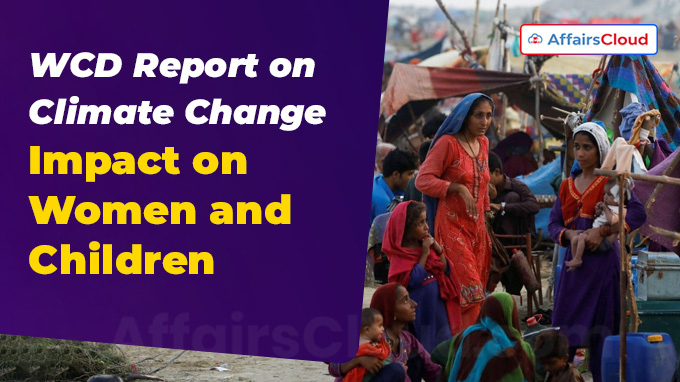 In April 2025, the Ministry of Women and Child Development (MoWCD), released a scoping study titled “How Does Climate Change Impact Women and Children Across Agroecological Zones in India.” The study highlights that women, especially in poor and rural areas, are more affected by climate change because of their daily responsibilities and social roles. Children are also highly exposed to climate threats.
In April 2025, the Ministry of Women and Child Development (MoWCD), released a scoping study titled “How Does Climate Change Impact Women and Children Across Agroecological Zones in India.” The study highlights that women, especially in poor and rural areas, are more affected by climate change because of their daily responsibilities and social roles. Children are also highly exposed to climate threats.
- Since many rural women work in agriculture, climate disasters like floods, droughts, and cyclones hit their livelihoods hard.
- India lacks proper gender-specific data on how such disasters affect women, which is essential for creating effective disaster response policies.
Highlights:
Key Impacts of Climate Change:
i.The effects of climate change, especially on women and children, are different in each of India’s 20 agroecological zones.
ii.The situation is complex as states like Jharkhand, Gujarat, Maharashtra, and Andhra Pradesh (AP) have five agroecosystems each, while regions like the North Eastern Hills(Agro-eco region 17 – covers nine states) and Western Coastal Plains (Agro-eco region 19 – cover eight states), requiring inter-state coordination.
iii.Heatwaves have become much more common in India, increasing about 30 times by 2022. This rise in temperature is especially dangerous for certain groups. Pregnant women, older women, outdoor workers, and poor women are at the highest risk.
iv.Young children, especially those under 5 years old, are at serious risk during extreme weather events like heatwaves. Between 2000 and 2016, India reported over 17,000 child deaths due to natural disasters.
Key Facts:
i.According to researchers, 27 out of 36 Indian states and Union Territories (UTs) are at high risk of disasters caused by changing weather patterns, such as cyclones, floods, and drought Scientists have also warned about future risks like rising sea levels, melting glaciers, and depleting groundwater.
ii.The 2023 ND-GAIN (Notre Dame Global Adaptation Initiative) index ranked India 138th out of 185 countries, showing that the country is highly vulnerable to climate change and not fully prepared to deal with its effects.
iii.According to the United Nations Development Programme (UNDP), women and children are 14 times more likely to die in disasters than men.
iv.In United Nations International Children’s Emergency Fund (UNICEF)’s 2021 Child-focused Climate Risk Index, India ranked 26th out of 163 countries, which means that children in India face serious dangers from the ongoing impacts of climate change.
Key Initiatives:
i.The Aapda Mitra scheme, run by the NDMA, has trained around 100,000 volunteers, including over 20,000 women, to help during disasters.
Note: The scheme was launched in 2016, focuses on promoting a culture of volunteerism in Disaster Risk Reduction (DRR) and response.
ii.The state of Odisha is setting an example in tackling these issues. The state has started adding gender-focused plans in all its disaster-related policies, with help from the United Nations Population Fund (UNFPA).
- Odisha has already formed 21 district-level gender cells and is also training young people in villages to handle disasters. This year, they plan to train 10,000 village volunteers.
iii.In Ahmedabad, Gujarat, the Self Employed Women’s Association (SEWA) has launched an innovative heat micro-insurance programme to support informal women workers.
About the Ministry of Women and Child Development(MoWCD):
Union Minister– Annpurna Devi (Constituency- Kodarma, Jharkhand)
Minister of State (MoS)– Savitri Thakur (Constituency- Dhar, Madhya Pradesh, MP)




